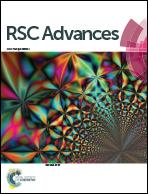Visible-light-mediated antifungal bamboo based on Fe-doped TiO2 thin films
Abstract
TiO2-based photocatalytic disinfection has been proved as one of the feasible approaches for the control and inhibition of the growth of mould fungi on woody materials. However, the wide band gap of TiO2 (3.2 eV) limits the efficient absorption of sunlight in the visible region. In this study, visible-light-mediated antifungal bamboo based on Fe-doped TiO2 thin films was successfully fabricated through a facile one-step homogeneous precipitation method. XRD studies confirmed that all of the as-prepared TiO2 nanoparticles on the bamboo surface were anatase phase. Fe-doped TiO2 thin films were found to grow on the bamboo surface by the self-aggregation of nanoparticles with an average diameter of about 9.7 nm and a surface area of about 90.96 m2 g−1. The Fe-doped TiO2/bamboo samples looked identical to original bamboo as there was no essential effect on the optical properties of the bamboo surface. Moreover, the antifungal activity of the as-prepared samples against mould fungi was investigated under natural weather conditions. Compared with original bamboo and TiO2/bamboo, the Fe-doped TiO2/bamboo exhibited much higher inhibition ability to mould fungi under the natural environment, which is due to the fact of the red shift of the absorption edge of the Fe-doped TiO2 nanostructures on the bamboo surface. UV-vis DRS also revealed that the band gap of Fe-doped TiO2 nanostructures was obviously decreased, extending the light response of TiO2 from ultraviolet to the visible light region. The research result may provide a general and effective approach to prepare visible-light-driven photocatalysts used for inhibition of the growth of mould fungi on the surface of bamboo.



 Please wait while we load your content...
Please wait while we load your content...